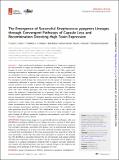Files in this item
The emergence of successful Streptococcus pyogenes lineages through convergent pathways of capsule loss and recombination directing high toxin expression
Item metadata
| dc.contributor.author | Turner, Claire E | |
| dc.contributor.author | Holden, Matthew T G | |
| dc.contributor.author | Blane, Beth | |
| dc.contributor.author | Horner, Carolyne | |
| dc.contributor.author | Peacock, Sharon J | |
| dc.contributor.author | Sriskandan, Shiranee | |
| dc.date.accessioned | 2019-12-16T12:30:09Z | |
| dc.date.available | 2019-12-16T12:30:09Z | |
| dc.date.issued | 2019-12-10 | |
| dc.identifier | 264328135 | |
| dc.identifier | 79708ec3-1f99-4894-916b-d770da1edbe2 | |
| dc.identifier | 31822586 | |
| dc.identifier | 85076363738 | |
| dc.identifier | 000507988700013 | |
| dc.identifier.citation | Turner , C E , Holden , M T G , Blane , B , Horner , C , Peacock , S J & Sriskandan , S 2019 , ' The emergence of successful Streptococcus pyogenes lineages through convergent pathways of capsule loss and recombination directing high toxin expression ' , mBio , vol. 10 , no. 6 , e02521 , pp. 1-19 . https://doi.org/10.1128/mBio.02521-19 | en |
| dc.identifier.issn | 2150-7511 | |
| dc.identifier.other | ORCID: /0000-0002-4958-2166/work/66070042 | |
| dc.identifier.uri | https://hdl.handle.net/10023/19135 | |
| dc.description | Funding: Health Innovation Challenge Fund (WT098600, HICF-T5-342), a parallel funding partnership between the Department of Health and the Wellcome Trust; UK Clinical Research Collaboration (UKCRC, National Centre for Infection Prevention & Management); and the National Institute for Health Research Biomedical Research Centre awarded to Imperial College London. | en |
| dc.description.abstract | Gene transfer and homologous recombination in Streptococcus pyogenes has the potential to trigger the emergence of pandemic lineages, as exemplified by lineages of emm1 and emm89 that emerged in the 1980s and 2000s, respectively. Although near-identical replacement gene transfer events in the nga (NADase) and slo (streptolysin O) loci conferring high expression of these toxins underpinned the success of these lineages, extension to other emm genotype lineages is unreported. The emergent emm89 lineage was characterized by five regions of homologous recombination additional to nga-slo, including complete loss of the hyaluronic acid capsule synthesis locus hasABC, a genetic trait replicated in two other leading emm types and recapitulated by other emm types by inactivating mutations. We hypothesized that other leading genotypes may have undergone similar recombination events. We analyzed a longitudinal data set of genomes from 344 clinical invasive disease isolates representative of locations across England, dating from 2001 to 2011, and an international collection of S. pyogenes genomes representing 54 different genotypes and found frequent evidence of recombination events at the nga-slo locus predicted to confer higher toxin genotype. We identified multiple associations between recombination at this locus and inactivating mutations within hasAB, suggesting convergent evolutionary pathways in successful genotypes. This included common genotypes emm28 and emm87. The combination of no or low capsule and high expression of nga and slo may underpin the success of many emergent S. pyogenes lineages of different genotypes, triggering new pandemics, and could change the way S. pyogenes causes disease. IMPORTANCE Streptococcus pyogenes is a genetically diverse pathogen, with over 200 different genotypes defined by emm typing, but only a minority of these genotypes are responsible for the majority of human infection in high-income countries. Two prevalent genotypes associated with disease rose to international dominance following recombination of a toxin locus that conferred increased expression. Here, we found that recombination of this locus and promoter has occurred in other diverse genotypes, events that may allow these genotypes to expand in the population. We identified an association between the loss of hyaluronic acid capsule synthesis and high toxin expression, which we propose may be associated with an adaptive advantage. As S. pyogenes pathogenesis depends both on capsule and toxin production, new variants with altered expression may result in abrupt changes in the molecular epidemiology of this pathogen in the human population over time. | |
| dc.format.extent | 20 | |
| dc.format.extent | 3907193 | |
| dc.language.iso | eng | |
| dc.relation.ispartof | mBio | en |
| dc.subject | Group A Streptococcus | en |
| dc.subject | NADase | en |
| dc.subject | Streptococcus pyogenes | en |
| dc.subject | Streptolysin O | en |
| dc.subject | QH426 Genetics | en |
| dc.subject | QR Microbiology | en |
| dc.subject | DAS | en |
| dc.subject | SDG 3 - Good Health and Well-being | en |
| dc.subject.lcc | QH426 | en |
| dc.subject.lcc | QR | en |
| dc.title | The emergence of successful Streptococcus pyogenes lineages through convergent pathways of capsule loss and recombination directing high toxin expression | en |
| dc.type | Journal article | en |
| dc.contributor.institution | University of St Andrews. School of Medicine | en |
| dc.contributor.institution | University of St Andrews. Biomedical Sciences Research Complex | en |
| dc.contributor.institution | University of St Andrews. Infection and Global Health Division | en |
| dc.contributor.institution | University of St Andrews. Infection Group | en |
| dc.identifier.doi | https://doi.org/10.1128/mBio.02521-19 | |
| dc.description.status | Peer reviewed | en |
This item appears in the following Collection(s)
Items in the St Andrews Research Repository are protected by copyright, with all rights reserved, unless otherwise indicated.

